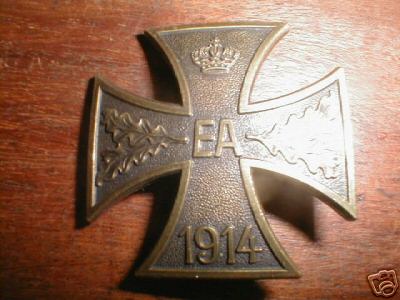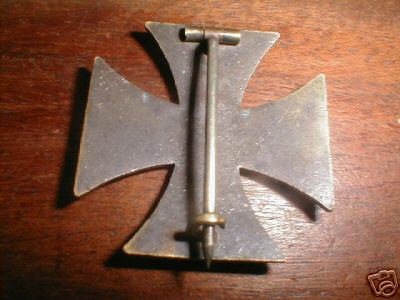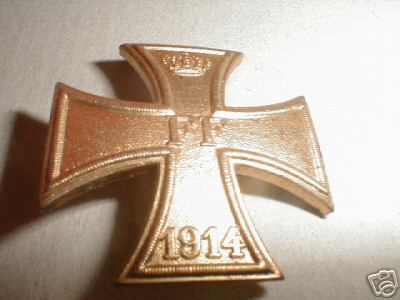-
Posts
949 -
Joined
-
Last visited
Content Type
Profiles
Forums
Blogs
Gallery
Events
Store
Posts posted by David Gregory
-
-
Paul,
I hate commenting on items like this that I have not had the opportunity to inspect first-hand, espacially as my interest in Luftwaffe collar tabs has virtually dried up.
That being said, the general quality of the tabs shown above are not what I would expect to see on authentic pieces.
Since the perceived quality of the bullion work is difficult to judge from the available image resolution, my main gripe is with the alignment of the insignia with reference to the tab edges. They just seem to be sufficiently off-centre, or closer to one edge than the other, that I would reject them as unacceptably poor quality, or rather modern copies.
I am sure there are better pieces to be found.
David
0 -
Stephen,
That looks really very good, especially considering how small it is.
Unfortunately, it tempts me to start looking at kits and wondering if I have the time, skill or patience again to tackle a model after a break of (insert large number here) years.
You seem to finish what many others never achieve. Look forward to seeing more,
David
0 -
Hi Dave, cheers. Its a really puzzling bar, you're right......I sometimes wish bars like these were researchable. Maybe someone who started as a medic and ended up a combatant, or vise-versa???
Its a toughie!
cheers Jason
Jason,
It might also just be the way that the awarding bodies classified the type of award.
Award groups to military medical personnel might contain combattant awards for front-line service, and non-combattant awards for men in similar units who never got close enough to the front to even hear a barrage. I have seen both as document groups with the associated medal bars, and at least one documented group which suggested that a combattant award was bestowed by one state for front-line service, and a non-combattant award by another state for service probably far from the front during a different phase of the war.
To throw further confusion on the issue, I have a Milit?rpass and other documents to a man who mainly served with Saxon medical units from 1914 to 1918 and was awarded the Saxon Friedrich-August-Medaille in silver, the EK2 and the Hessen Milit?r-Sanit?ts-Kreuz. The latter award was bestowed on both the red/white ribbon for non-combattants and the blue/red ribbon of the Hessen Allgemeines Ehrenzeichen for combattants. Judging by the service record entries in his Milit?rpass, he was probably awarded the cross on the blue/red ribbon for combattants and I assume his EK2 was also on the black/white ribbon.
David
0 -
That is an astonishing group, of which I would like to see the rest.
The passage quoted in German above translates approximately as follows:
Report by Lt.d.R. Loibl on his capture:On 31 August 1916 I made a long-distance flight with Unteroffizier Busse as my pilot from bayer. Feldfliegerabteilung 4 b from Kowel to Kowno. The aircraft took a shot above Kowno and we had to make an emergency landing, as the cooling water was draining out of the tank and the motor was overheating.
We landed next to a single farm with the intention to repair the damage. Threatening the owner with a pistol, we gathered what we needed.
After we had been working for about an hour, we suddenly started receiving strong and effective fire in the right flank from a wood at a distance of about 300 m. We received several more rounds in the machine. Since fire from such a short distance would have quickly dispatched us, I had little time to react and quickly decided to take the machine gun and placed the wood under strong and continuous fire.
Russian soldiers in the wood had already formed up and approached us under cover and had occupied the edge of the wood. My strong machine gun fire silenced the Russian fire, which meant that nothing more was undertaken against us during the further 1 ? hours that we needed for the repair. When the motor was finally repaired, we taxied off and had to pass the dairy as the terrain left us no other choice. This is where the accident happened when a cow from a grazing herd took fright and ran onto the runway and just clipped the propeller and undercarriage, as we weren?t any higher. We crashed right next to the farm, and the soldiers and farmhands gathered there leapt on us and took us prisoner. This was at about 12 o?clock midday.
We were transported to Kowno in the evening.
I declare that this statement is made to the best of my knowledge and conscience.
Hans Loibl
Ltn.d.Res. a.D.
I look forward to seeing the rest of the group.
David
0 -
that`s a great group - the Alsen and D?ppel crosses are not very often seen.... and then on the bar and together with the documents!!!!

I agree - WOW.
0 -
From http://www.gwpda.org/medals/italmedl/italy.html
Ordine della Corona d'Italia (Order of the Crown of Italy): established by Royal Decree on 20.2.1868 by King Vittorio Emanuele II after the annexation of the Venetian Region and the completion of Italy's unity. It was awarded to Italian and foreigner citizens, both civilians and soldiers, as a token of national gratitude for their accomplishments which could include a long military career with a 'clean' record. This Order was less exclusive than the Order of the Annunciation or the Order of St. Maurice and Lazarus.It was divided in the usual five classes, worn in the customary ways: Knight, Officer, Commander, Grand Officer, Grand Cross. Between the cross arms were four knots of Savoy ("love knots) in gold filigree. On the obverse the cross was "charg?" by the "Iron Crown" encircled in gold and blue; on the reverse there was a black eagle with the Arms of Savoy "en coeur", encircled in red. The Order was named after the famed "Iron Crown", kept in Monza's Cathedral and allegedly crafted from a nail of the Holy Cross. The crown was used for the coronation - among many others - of Charlemagne, Napoleon I and all the Kings of Italy. With the fall of monarchy the order, being considered national, and not of dynastic property, was discontinued and replaced in 1951 by the Meritorious Order of the Republic of Italy ("Ordine al Merito della Repubblica Italiana").
0 -
Haynau,
That is a very attractive set. I have some documents to a former German officer and diplomat who received a lower grade of the order and I would like to obtain a nice example to match the documents.
As I understand it, this order has been (or was) awarded over a long period. Do you know how old your example is and if there are any distinguishing features to determine the age of the various grades?
Thanks in advance,
David
0 -
My Great Uncle Walter served with the RFC during WW1 and as a police officer loaned by the British to what later became Iraq in the early 1920s. There he met my Great Aunt Olga who came from a White Russian family and had fled together with her sister from the revolution.
We only knew that the rest of her family had been killed and that she would never be able to return.
If ever surviving archives or records become available, I would like to try to find out more about her family roots. The chances seem very slight, but who 20 years ago could have imagined the exchange of information on obscure aspects of military history such as we enjoy here.
Provided the records have not perished, perhaps we will find some information one day.
0 -
Chuck,
I meant no slight to the Georgians, but referred rather to the way things are done in some of the former Soviet states.
A work colleague of mine (a Russian) who travels extensively in the CIS/Russian Federation sometimes tells us about the way business is "facilitated" in the "Wild East". Even allowing for some exaggeration by western media, I am sure your concern for your own safety was not entirely unfounded.
You are very fortunate to be able to visit an interesting country in such a fast-moving part of its history. I certainly envy your visits there.
David
0 -
This was a very violent and lawless period in Georgia, the first year since Tbilisi had fallen. The wearer of this badge likely was an enforcer of some sort. Many Georgian war lords, gang leaders and street toughs who thought they could read the writing on the wall allied themselves with the conquering Red Army. This may have been worn by someone like that whose work pleased the new government.
Things don't seem to have changed much, do they?
0 -
Chuck,
Although we will probably never know much more about him than what you can tell us, he is at least "known" and being viewed by more people than he could ever have imagined so long after he passed away.
I sometimes wonder if anything we leave behind will ever be paid as much attention by collectors in the not-too-distant future.
With groups such as the one you show here, we seem to accumulate snapshots of history that were not significant enough to make the history books (expect perhaps for items attributed to historical figures).
Are there any archives or records that might reveal why he was awarded his St. George Cross?
David
0 -
Chuck,
I know nothing about Imperial Russian militaria, but I really enjoy seeing attributable items, especially when they are works of art in their own right.
David
0 -
Wild Card,
Thanks for showing that. I suspected to see something very similar to the later Allgemeines Ehrenzeichen, as Dave D. pointed out above.
So many 2-medal bars of that era seem to be the standard Kriegsdenkm?nze and Centenary medal, this one is a refreshing change.
It must also be fairly scarce.
David
0 -
Glenn,
Sorry if my answer isn't very helpful, but decipering the handwriting is probably the easiest part of having something like this translated.
The stories should be fairly straightforward, but poetry is usually difficult, if not sometimes impossible to translate.
You will be lucky if you find someone that is prepared to try their hand at translating the poetry and who is able to make a good job of it.
Please show us some scans.
David
0 -
If the ribbon is black with white stripes, the only obviously confusing thing about that is the W?rttemberg award attached to bar for an EK2 (or perhaps some other Prussian decoration).
Is that the explanation or is there something more to this?
0 -
Gentlemen,
A Saxon example.
Wild Card,
Would it possible to see a scan of the back, please?
Many thanks in advance,
David
0 -
Chuck,
Although all this "Eastern Block" stuff is not what I collect, I do enjoy looking at it.
Since I mostly collect documents, I would certainly be pleased to see more of what you have.
Many thanks in advance,
David
0 -
In the context of Germany before 1945, the term "Saupreuss" comes to mind... It's fallen out of use these days, but that doesn't mean a German wouldn't know what it meant if someone called them one.
Please be assured that the term "Saupreuss" (or "Saupreiss" depending the dialect) is still very much alive and well in the south of Germany.
Despite the legacy of post-1945 displaced persons and the fact that freedom of movement in Germany means that many people live and work in other parts of the country, regional origins and accents are still important aspects of popular humour (yes, some Germans do have a sense of humour) and "foreigners" (e.g. Saxons in the Ruhrgebiet, Wessies in the east or northeners in the south) still stand out like a sore thumb.
I recently attended a conference where a presentation was given by a speaker from India, whose English is impeccable. The German participants, even the majority whose command of English is very good, all scrambled for their headsets and listened to the translation provided by the interpreters, as the Indian speaker has such a strong accent that it is sometimes difficult to know what he is talking about.
When a Saxon sales manager took the floor to give his presentation in German, a few of his colleagues from Baden-W?rttemberg made a show about using their headsets to listen to the English translation provided by the interpreters (for those of you not familiar with it, this is an example of German humour).
0 -
It says "Albrecht" what looks like "Eihren" as last name "1931." "seinem lb. Br?der Herman" (this is the German handwriting style which places a flat line over a single letter to indicate there were two of the same letter) and "z. 3.7.32."
The flat line sometimes seen above single letters in German handwriting is either a badly written Umlaut, or more usually a sign used above the letter u to show that it is not an n. Without this distinction, it is almost impossible to read the squiggles that some people call handwriting.
You also see the same sort of thing in Russian handwriting, but with the line below the ш to show that the squiggles at the bottom of the character are closed, for example.
0 -
I forgot to add this link, which is a good starting point for further information on Ernst J?nger:
0 -
Jens,
There seems to be a rather small, but nevertheless discernible signature shown at http://www.perlentaucher.de/buch/13964.html
If the link shows his signature, then I think the text above is probably something else.
David
0 -
@Wild Card
Thank you very much for showing the essential comparison item. I was aware that the cross and crown were separate pieces, but I hadn't seen the locking arrangement on this before.
I once had the opportunity to inspect what was considered by a number of German collectors as a good original, and noticed what I thoought was a repair to the catch. With hindsight, it would seem that I was looking at what was left of the pin locking arrangement after it had (been) broken off.
@notned
My intention is not to scare people, but simply to raise awareness of what pitfalls can await the unwary. My only experience with 1939 EK1s turned into a Floch disappointment, which, besides the spiralling prices for essentially very common awards, also put me off looking for Third Reich awards for good. Since Imperial documents offer me much more research potential, and I only collect representative examples of the awards to match them if the awards are missing from the groups, I don't want to repeat my Floch experience with Imperial awards. As collectors disenchanted with constantly improving Third Reich fakes turn to Imperial militaria, it will only be a question of time before the fake peddlers meet demand in this field, too. The only way to beat them, in my view, is to identify the fakes and reveal who sells them. Only by sharing this knowledge do we have a chance of enjoying, rather than being disappointed and frustrated by the items we crave. This is not meant to be a witch hunt, and the fake sellers can open as many new eBay accounts as they need, but I hate to see the prices that some accepted fakes seem to command in auctions in which the bidder lists are kept secret.
@Jens
Excellent idea.
If anyone else has other examples of bad sellers and fakes awards, please share them with us so that other people don't make the same mistakes again.
0 -
A new find sunday morning for a very low price.
Regards
Christophe
Very nice find, Christophe. Is that a single ribbon woven to show the colours of both awards or just two ribbons positioned close together?
The crossed swords are different from the example I posted in #69, but otherwise they are both nice examples of what a junior officer probably had to show for surviving the war.
0 -
Jens identified froschhuettl in connection with a fake Ernst-August Kreuz 1914, Braunschweig 1. Klasse in auction 6214597022.
The is the cross sold for EUR 82.08:
[attachmentid=17460]
[attachmentid=17461]
Surprisingly, both he and the high-bidder 16erdragoner in the above-mentioned auction for the W?rttemberg cross give their locations as L?neburger Heide. Jens also identified 16erdragoner as the seller of a fake Mecklenburg KVK 1. Klasse in auction 6215097865. Here are the images captured for posterity:
[attachmentid=17462]
[attachmentid=17463]
Equally surprising is the similarity between the backgrounds used for some images posted by both froschhuettl and 16erdragoner. Take a look at their auctions at http://search.ebay.de/_W0QQsassZfroschhuettlQQhtZ-1 and http://search.ebay.de/_W0QQsassZ16erdragonerQQhtZ-1
Maybe I am paranoid, but there is no denying that a pattern is emerging.







 0
0




Turkish awards to Germans
in Turkey
Posted
Ribbon bar and all pin-back awards for service dress, medal bar and all accoutrements for full dress.